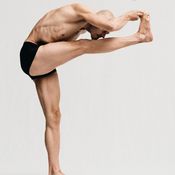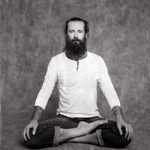
Note: Sri K. Pattabhi Jois introduced this pose only after the student had mastered the supine version that comes toward the end of the Primary series. This is why the green line skips over this pose. The green line indicated the flow for beginners.
The flow of movement for this pose starts directly in standing.
Vinyāsa 1 – Inhale:
Inhale your right arm in front of you, approximately horizontal. At the same time, lift the right leg straight up. A little swing is enough to bring the foot high enough to catch the big toe with the index and middle finger of your right hand.
Note: Be sure to really try to develop balance in this pose. Of course using a wall you can hold your leg higher, but there are lots of opportunities in the Aṣṭāṅga Yoga to develop flexibility. Focus here on balance.
Vinyāsa 2 – Exhale:
Exhale the torso over the extended right leg as you draw your right elbow to the side. To maintain balance, the center of gravity of your pelvis has to go as far backwards and the upper body forwards. Traditionally the gaze is to the big toe (Pādāgra Dr̥ṣṭi).
Stay here until the fifth breath.
Try this: In time you will be able to touch the right shin with your chin while your leg
The flow of motion continues into the following postures (greyed out, description on following page)
Effect: The standing big toe to hand pose (utthita hasta pādāṅguṣṭhāsana) in variant A combines balancing on one leg with strength and flexibility. The more important aspect of this pose is the balance challenge of the standing leg. Balance requires time to develop. Good balance helps us to maintain stability and stand strongly, even on shaky ground.
-
Sehr schön dargestellt und super mit den ganzen zusatzinfos zu jeder Position!
Wird es irgendwann vielleicht auch einen Leitfaden mit Traditional und Full Count geben, ähnlich dem Basic Leitfaden?
[...] Sehr schön dargestellt und super mit den ganzen zusatzinfos zu jeder Position!
Wird es irgendwann vielleicht auch einen Leitfaden mit Traditional und Full Count geben, ähnlich dem Basic Leitfaden?
Namaste :-)-
Wau. Danke.
In der Tat wird es auch bald einen Traditional Form Kurzleitfaden ... und sogar Buch geben. :)
Der Count ist in der Basic Form und in der Traditional Form übrigens gleich. Der [...] Wau. Danke.
In der Tat wird es auch bald einen Traditional Form Kurzleitfaden ... und sogar Buch geben. :)
Der Count ist in der Basic Form und in der Traditional Form übrigens gleich. Der Unterschied liegt lediglich in der Form. Hier ein Link zum Kurzleitfaden (Basci Form):
https://de.ashtangayoga.info/shop/buecher-cds/buch/180901-kurzleitfaden-ashtanga-yoga-1-serie-basic-form/
Eine kleine Erklärung:
Form:
Bais Form führen wir die Übungen in einer für viele Menschen leicht zugänglichen Weise aus, in der Traditional Form führen wir die Übungen so aus, wie sie Pattabhi Jois unterrichtet hat.
Count:
Der Count ist wie die Melodie einer Bewegungsfolge. Also wie Atem und Bewegung zusammen kommen. Hier können wir in beiden Formen synchron üben, so wie verschiedene Instrumente das gleiche Musikstück spielen können. Der Full-Count geht dabei immer von Stand zu Stand. Das ist die Bild-Folge unter dem Detail Foto. Der Traditional Count kürzt etwas ab. So hat Pattabhi Jois gecountet. Das ist die orangne Linie oben. Die grüne Linie ist ein Lern-Count, der sich für Anfänger besonders gut eignet. Diese Übung hatte Pattabhi Jois für Anfänger übersprungen. Daher geht die grüne Linie vorbei.
Viel Freude beim Üben wünscht Dir
Ronald -
Danke für die schnelle Rückmeldung und die Erklärung! Viele Grüße aus Hannover :-) Danke für die schnelle Rückmeldung und die Erklärung! Viele Grüße aus Hannover :-)
-
Top!
- Grüße zurück! Top!
- Grüße zurück!
-





Messages and ratings